Get Zerched!
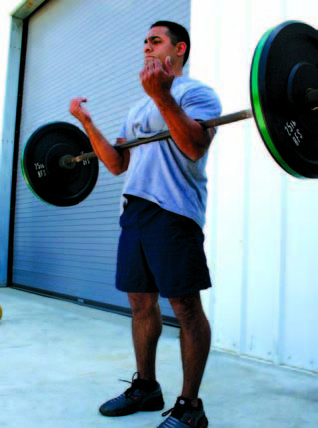
If you’ve ever been lost, needed a bathroom and wandered through a modern Globo Gym, you were likely amazed at the stupefying profusion of gear and gizmos designed to tighten, tone and separate those hard to reach areas. 10-20 permutations for curls, calf raise options that allow for soleus activation on the eccentric portion of dorsiflexion, but gastrochnemuis activation during concentric plantar flexion… it’s fracking amazing! My Id, Ego and Superego have concocted some kind of analogy about building the better mouse trap and catching lots of gym rats… but my inner child is an attention hog and has pooped itself again and distracted my subconscious so I’ll just let that go. My point here is that it may look like the big box gyms have cornered the market on variety in training but that just ain’t so. We just need to look back to see our way through Globo-Hell to a brighter, Zerchier future.

100 Non-Pornographic uses for a Barbell
It may come as a surprise to some of you youngsters, but there was a time when “My Space” was part of a lame pick up line, Britney Spears was hot and not crazy trailer trash, and crap like Hammer Strength, Nautilus and SoloFlex did not exist. This was after the invention of the wheel but before the complete domestication of Homo North Americis. Back in this remote past people entertained themselves with exercise equipment like barbells, dumbbells, rings, pommel horses and kettlebells. It was a wild and lawless time… people lifted things without belts, super suits and polymetalic exoskeletons. They pressed things overhead and squatted ALL THE WAY down. I know… it may sound like madness but this is the legacy of our ancestors and oddly enough, they were none the worse for their activities. You might wonder what on earth our progenitors did with such simple apparatus as those mentioned. No selectorized weight stacks, real Faux-leather seats or instructional placards. No friends, our distant ancestors relied on novel movements with names like Bent Press, Hachenschmidt’s and Zerchers.
Have a Zercher and a Smile
There are several related movements with the name Zercher. The commonality among these derivatives and what gives them their inherent “Zerchieness” is the carrying position of the barbell in the crook of the arms. Historically the Zercher started from the ground and was either scooped up in the elbows and lifted directly (a flexibility intensive version) or the barbell was deadlifted, placed on the thighs and then the arms were threaded under the bar to the classic Zercher position. This is the version still contested in the US All Around Weightlifting Federation. The most common modern permutation of the Zercher is the Z-squat in which the barbell is held in a power rack at about navel height where it is a comparatively easy matter to lift the barbell out of the rack and get squatting! This last variety is occasionally used in Conjugate Method max effort days.
Before we get to the how-to section I just want to mention that the Zercher lift is best approached with light-weight and perhaps some elbow protection like a towel rolled around the barbell. Some people hold a board in the crook of the elbows for very heavy efforts… that’s tough as hell but one might consider something like a front squat if the weights are heavy enough to require a piece of lumber for protection. OK, let’s get Zerching!
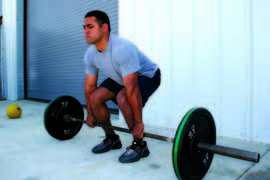
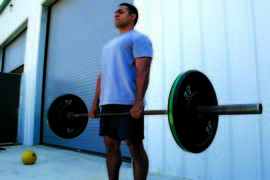
Deadlift start, deadlift finish
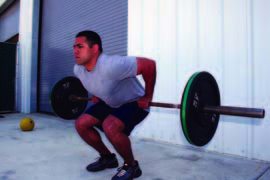
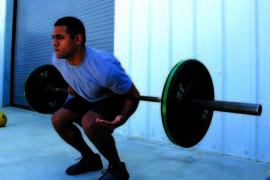
Hip Hold, One arm under
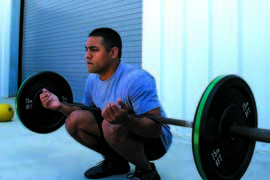
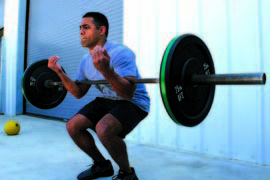
Two arms under, Zercher midway
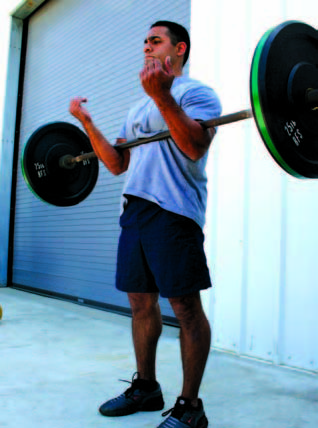
Zercher finish
Competition Zercher
For the competition Zercher as contested in the USAWA, one deadlifts the bar to full lock out. (insert deadlift start and finish photos) One now bends at the waist and knees allowing the bar to rest on the thighs (insert hip hold). One now threads the arms under the bar such that the bar is resting in the crooks of the elbows (insert one arm under and two arms under). All slack is removed from the body and one stands upright (insert zercher midway and finish). For the competition lift one must return the bar to the floor under control. For general training one may perform repetitions, raising and lowering in what is essentially the Zercher squat.
Zerhcer/Spider lift
This Zercher variant increases the difficulty and range of movement dramatically. In this movement one threads the elbows under the barbell directly and does not employ the deadlift (insert spider lift start). Once the bar is fixed in the crook of the arms tension is slowly increased throughout the body. One must maintain a normal lordotic arch in the low back, weight driving through the heels and a neutral cervical spine by shifting ones gaze 6-12’ forward (insert spider lift knee level). One drives the weight upwards and once past the knees, drag the elbows along the tops of the thighs until the barbell is near the hips (insert spider lift mid thigh). From here one may bring the torso into an upright position simultaneous with hip extension. One reverses the movement by folding at the hips and slightly bending the knees allowing the elbows to trace to the hips. One may now extend forward and once past the knees, lower the barbell and the body to the floor.
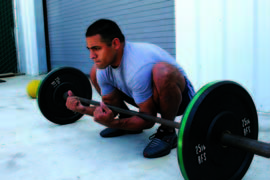
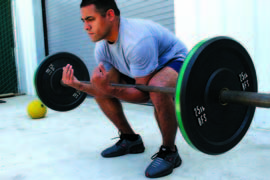
Spider lift start; spider lift knee level
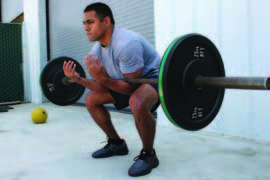
spider lift mid thigh
Zercher Squat
This version is quite simple compared to the previous two options. It does lend itself to greater loading but I’m not a huge fan. Place the barbell in a power rack at navel height. Fix the barbell in the crooks of the elbows, tense the body and stand erect with the eyes forward. Typically one performs a squatting movement by bending at the hips and knees allowing the barbell to touch and go on the thighs as one reverses the movement.
Seated Zercher
This is effectively a good-morning variation. While seated on a box or bench that is around knee height one leans forward, fixes the barbell into the crooks of the arms, tenses the body and uses primarily the low back to haul the weight up to a seated position. (Insert seated Zercher sequence) Use VERY light weight on this movement! Depending upon flexibility both the seated Zercher and the spider lift may be performed with a rounded back. This is not grounds for panic although care must be used to avoid injury. Many instances in sport and life see a full body lift performed with a rounded back. Wrestling, police arrest and control techniques and firefighting come immediately to mind. Rounded back training can be both safe and beneficial is approached with care and very light weights in the initial stages. Don’t be a wanker!
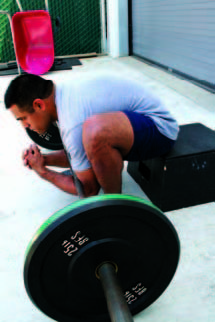
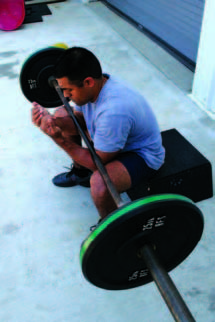
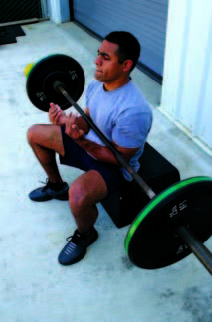
Programming
The Zercher can add some nice variety to your training and it will scare the hell out of people in a commercial facility. Start with very light weights, for example staring with an empty bar of dowel using the competition form of deadlifting the weight then fixing the weight in the crook of the elbows. Keep the reps relatively low (3-5) but set high (5-10) to built confidence in the movement and a technique base. As you gain confidence in the movement you can experiment with higher reps as a conditioning tool or a greater load as a strength stimulus. The abs, low back and quads take the brunt of the fun with this movement so plan on being fatigued in those areas. All right kiddos! Get Zerching!

100 Non-Pornographic uses for a Barbell
It may come as a surprise to some of you youngsters, but there was a time when “My Space” was part of a lame pick up line, Britney Spears was hot and not crazy trailer trash, and crap like Hammer Strength, Nautilus and SoloFlex did not exist. This was after the invention of the wheel but before the complete domestication of Homo North Americis. Back in this remote past people entertained themselves with exercise equipment like barbells, dumbbells, rings, pommel horses and kettlebells. It was a wild and lawless time… people lifted things without belts, super suits and polymetalic exoskeletons. They pressed things overhead and squatted ALL THE WAY down. I know… it may sound like madness but this is the legacy of our ancestors and oddly enough, they were none the worse for their activities. You might wonder what on earth our progenitors did with such simple apparatus as those mentioned. No selectorized weight stacks, real Faux-leather seats or instructional placards. No friends, our distant ancestors relied on novel movements with names like Bent Press, Hachenschmidt’s and Zerchers.
Have a Zercher and a Smile
There are several related movements with the name Zercher. The commonality among these derivatives and what gives them their inherent “Zerchieness” is the carrying position of the barbell in the crook of the arms. Historically the Zercher started from the ground and was either scooped up in the elbows and lifted directly (a flexibility intensive version) or the barbell was deadlifted, placed on the thighs and then the arms were threaded under the bar to the classic Zercher position. This is the version still contested in the US All Around Weightlifting Federation. The most common modern permutation of the Zercher is the Z-squat in which the barbell is held in a power rack at about navel height where it is a comparatively easy matter to lift the barbell out of the rack and get squatting! This last variety is occasionally used in Conjugate Method max effort days.
Before we get to the how-to section I just want to mention that the Zercher lift is best approached with light-weight and perhaps some elbow protection like a towel rolled around the barbell. Some people hold a board in the crook of the elbows for very heavy efforts… that’s tough as hell but one might consider something like a front squat if the weights are heavy enough to require a piece of lumber for protection. OK, let’s get Zerching!


Deadlift start, deadlift finish


Hip Hold, One arm under


Two arms under, Zercher midway

Zercher finish
Competition Zercher
For the competition Zercher as contested in the USAWA, one deadlifts the bar to full lock out. (insert deadlift start and finish photos) One now bends at the waist and knees allowing the bar to rest on the thighs (insert hip hold). One now threads the arms under the bar such that the bar is resting in the crooks of the elbows (insert one arm under and two arms under). All slack is removed from the body and one stands upright (insert zercher midway and finish). For the competition lift one must return the bar to the floor under control. For general training one may perform repetitions, raising and lowering in what is essentially the Zercher squat.
Zerhcer/Spider lift
This Zercher variant increases the difficulty and range of movement dramatically. In this movement one threads the elbows under the barbell directly and does not employ the deadlift (insert spider lift start). Once the bar is fixed in the crook of the arms tension is slowly increased throughout the body. One must maintain a normal lordotic arch in the low back, weight driving through the heels and a neutral cervical spine by shifting ones gaze 6-12’ forward (insert spider lift knee level). One drives the weight upwards and once past the knees, drag the elbows along the tops of the thighs until the barbell is near the hips (insert spider lift mid thigh). From here one may bring the torso into an upright position simultaneous with hip extension. One reverses the movement by folding at the hips and slightly bending the knees allowing the elbows to trace to the hips. One may now extend forward and once past the knees, lower the barbell and the body to the floor.


Spider lift start; spider lift knee level

spider lift mid thigh
Zercher Squat
This version is quite simple compared to the previous two options. It does lend itself to greater loading but I’m not a huge fan. Place the barbell in a power rack at navel height. Fix the barbell in the crooks of the elbows, tense the body and stand erect with the eyes forward. Typically one performs a squatting movement by bending at the hips and knees allowing the barbell to touch and go on the thighs as one reverses the movement.
Seated Zercher
This is effectively a good-morning variation. While seated on a box or bench that is around knee height one leans forward, fixes the barbell into the crooks of the arms, tenses the body and uses primarily the low back to haul the weight up to a seated position. (Insert seated Zercher sequence) Use VERY light weight on this movement! Depending upon flexibility both the seated Zercher and the spider lift may be performed with a rounded back. This is not grounds for panic although care must be used to avoid injury. Many instances in sport and life see a full body lift performed with a rounded back. Wrestling, police arrest and control techniques and firefighting come immediately to mind. Rounded back training can be both safe and beneficial is approached with care and very light weights in the initial stages. Don’t be a wanker!



Programming
The Zercher can add some nice variety to your training and it will scare the hell out of people in a commercial facility. Start with very light weights, for example staring with an empty bar of dowel using the competition form of deadlifting the weight then fixing the weight in the crook of the elbows. Keep the reps relatively low (3-5) but set high (5-10) to built confidence in the movement and a technique base. As you gain confidence in the movement you can experiment with higher reps as a conditioning tool or a greater load as a strength stimulus. The abs, low back and quads take the brunt of the fun with this movement so plan on being fatigued in those areas. All right kiddos! Get Zerching!
| Robb Wolf is the author of the best-selling book The Paleo Solution, co-founder of the Performance Menu, and co-owner of NorCal Strength & Conditioning. |
Search Articles
Article Categories
Sort by Author
Sort by Issue & Date
Article Categories
Sort by Author
Sort by Issue & Date

